Foundation brush

Indeed, few people pay attention to the method of applying foundation. Most girls make do with their own fingers, not even realizing how some tools can make their lives easier and reduce makeup application time. One of these tools is a toner brush.
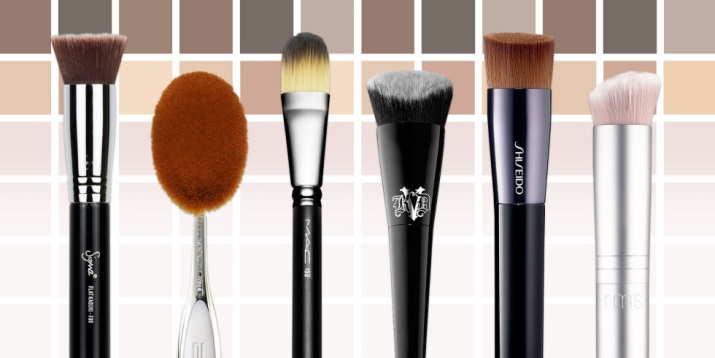
Peculiarities
The main feature of the makeup brush is its versatility - it can be used with foundation creams of any texture and density. She is also able to both evenly apply the cream and blend it with high quality. A quality brush does not leave streaks or streaks like a sponge or fingers, and also contributes to the smoothest and most even application of any facial product.

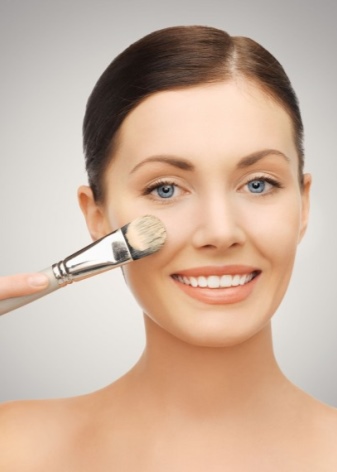
What should be?
The brush should not crumble - this usually happens with natural bristles, but an improperly packaged or made synthetic one can crumble. Therefore, if you see that the brush in the package is shabby, then you should not buy it. The pile must be safe and sound. The same applies to the handle - in cuts or scratches, with paint coming off, the handle does not inspire confidence, and, most likely, is not made in the highest quality way. The handle must be firm.
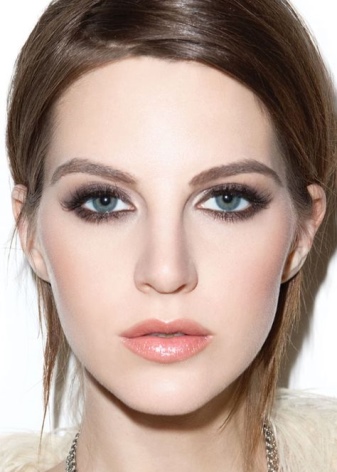
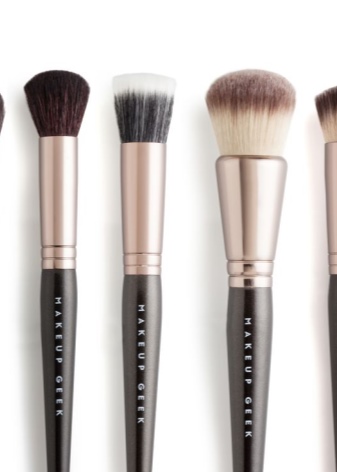
Of course, the length of the pile and its shape depends on what textures you use in makeup - oily, liquid or powder. For oily foundation creams, a flat synthetic brush ten centimeters long with a long handle is ideal (a brush brush is also suitable). For liquid - short kabuki with the same short pile (sponge-shaped brushes are also used, similar in their oval shape to sponge). Rounded has an arched shape and a long pile. Remember that the hairs do not always have to be the same length - the so-called duofiber has piles of different lengths, which allows you to apply the tone as naturally as possible.
What does it look like?
A foundation brush is a medium-sized wooden handle stuffed on top with bristles - artificial or natural.

materials
Materials for the manufacture of pile can be divided into two categories: artificial and natural. Despite the fact that the former are favorites because of the ease of application of the product and because of the easy care, the natural ones also have a number of advantages.
Natural materials for the manufacture of brushes - animal hair: raccoons, wild boars, squirrels or coh. Best of all, these brushes are used for shading and for applying powder products - blush, shadows, powder, highlighter. But for tone, a natural brush is not the best option. Moreover, they require scrupulousness in care - after all, the product remains on them, they absorb it and therefore wash worse. Chemical formulas destroy the villi of a poorly washed product, which helps to reduce its performance. They are also expensive.
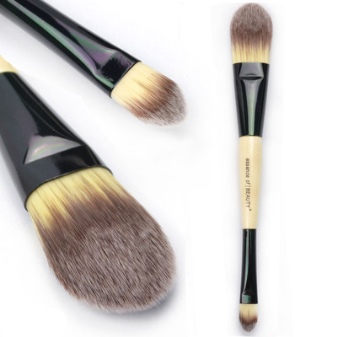
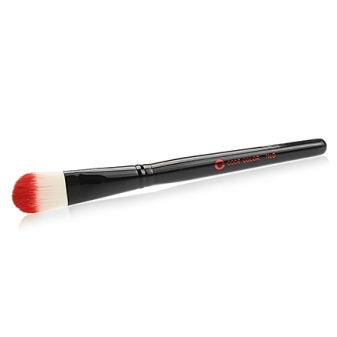
Artificial brushes are made of nylon or polyester. They are less demanding in care and do not crumble, unlike natural ones.Synthetic brushes do not absorb the product, they can apply it as evenly as possible, however, in shading they are not as good as natural ones. Therefore, the ideal option is a synthetic brush for application and natural for shading.
A special mention is worthy of a brush-duofiber. Firstly, it can be made both from artificial or natural material, and from a mixture of synthetics and natural fibers. Secondly, it has hairs of different lengths, which allows you to apply the cream most naturally, the effect of the mask in this case is excluded. Since the brush is made of different materials, this is also reflected in its appearance - the villi are often two-colored.
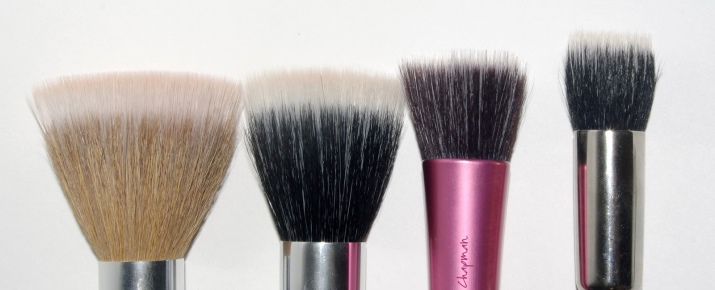
Firms
Recently, the manufacture of tools for applying makeup has become a very profitable business, so a huge number of companies began to produce entire lines of brushes, sponges or makeup brushes. For example, a brush is very popular MAC 187. It lasts much longer than others, made in Japan. The handle of the brush is wooden with a metal transition, the pile is very soft, double, that is, two types of hairs are used.

It is also impossible not to note the brush from Divage. It is also a duo-fiber, a brush with a straight cut and a flat base. It is more budgetary and suitable for beginners - it costs between 200-300 rubles. its length is 18 centimeters, of which 3 are pile, with a very comfortable handle and soft bristles. Very pleasant to use, has a soft double pile and does not prick at all. Made from synthetic material - nylon.

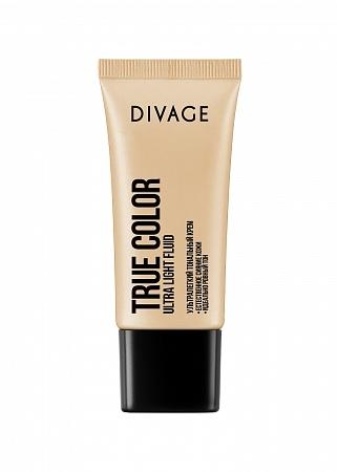
Avon presents several brushes for foundation at once. One of them is called "luxury» and can also be used for blush. The first thing that immediately attracts the eye is its appearance.It is made in silvery tones, the pile is duo-fiber, the piles are dark and light brown. Light metal handle, 17.5 cm long. The brush perfectly extinguishes the cream and distributes it well, also suitable for mousse textures. The second brush from the company is used directly for foundation. It is quite a bit smaller than the first brush - 17 cm - made of the same nylon and does not shed.


How to choose?
In order to choose the right brush, you need to pay attention to some criteria.
- Pile. In most cases, synthetic bristles are more comfortable to use than natural bristles. The exception is raccoon hair, but these brushes are very hard to find.
- Rigidity. A medium-hard brush is ideal, as a soft one is not able to apply the tone evenly, and a hard one can damage the skin and leave streaks on it.
- Handle and appearance. Of course, the brush should not have any external defects, the handle should tightly wrap around the pile so that it does not crumble.
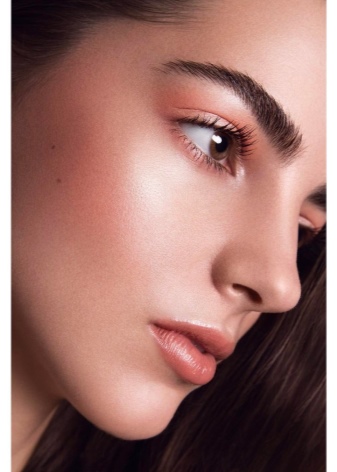

Which is better?
It should also be understood that different textures require different brushes - this is due to the consistency of the cream. For example, a brush called kabuki is best used with powder or liquid light foundation, primer, moisturizer. The pile can be natural or artificial. The handle is short, the pile is fluffy, resilient and soft, 3 to 5 centimeters long, cone-shaped.
A straight bristle brush, like kabuki, can be used for applying liquid textures, but it also works well with thick ones. It can be wide or narrow, natural or artificial. A brush with a rounded bristle is wide, arched, with a flat base.The pile is long - about 10-12 centimeters, universal - suitable for applying any textures, as well as powder, highlighter, bronzer or primer.
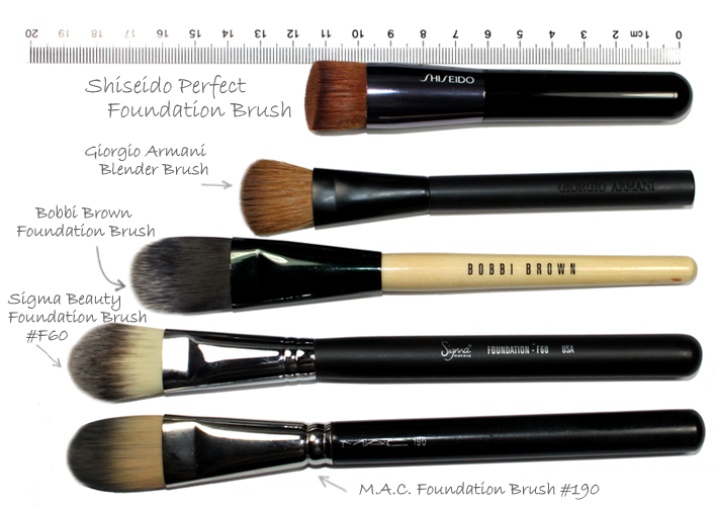
Subtleties of application
The method of applying foundation also depends on the type of brush.
- Kabuki. Used with liquid textures. The required amount of the product must be squeezed onto the back of the left palm, scooped up a little with a brush - the tone should completely cover the tip. It is applied in a circular motion from the center of the face to the periphery, paying special attention to the borders of the face (especially with the neck) and the T-zone. You can use this powder brush in the same way.
- Straight bristled brush. Take a little cream on the brush, place dots on the face in accordance with the zones - cheeks, chin, nose, forehead - and start stretching them all over the face, while blending from the center to the borders. This should be done with driving movements for a uniform tone. If your foundation sets quickly, you can apply it on the back of your hand.
- With rounded pile. With such a brush, the foundation must be distributed with patting movements, as if driving it into the skin until the difference between the shades is visible.
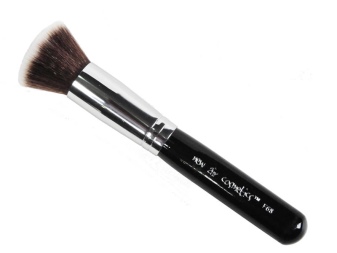
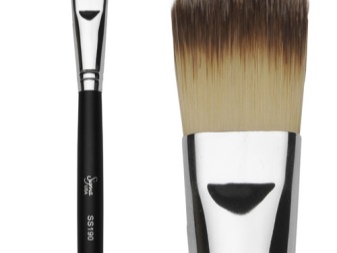
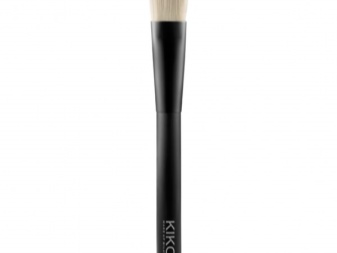

How to care?
It is advisable to wash the brush after each use - with dish detergent, liquid soap or an unloved facial foam, it does not matter. There are also special solutions for washing brushes, and you can also use micellar water. The main thing here is regularity. And, of course, caution - it is undesirable to pull the hairs. The washing procedure should take place in the most comfortable conditions. After washing, gently blot the brush with a tissue to simply remove excess moisture.Leave it in the fresh air, but in no case near the battery or other source of light / heat - the villi tend to dry.
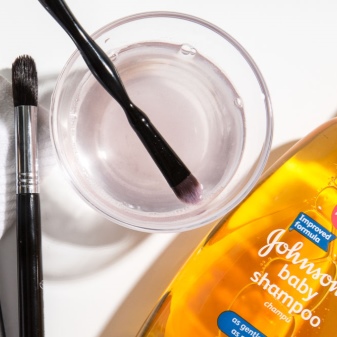
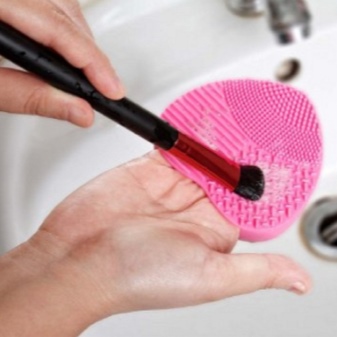
If you can't afford to clean your brushes every day (for example, hurry to work in the morning), then you can wipe them with a damp cloth after each use, and wash them thoroughly two to three times a week. For a pleasant aroma and additional disinfection, you can add a couple of drops of orange, rosemary or lemon oil to the soap suds. You may also need a special device - an egg for washing brushes. This is a small silicone sponge with several notches.
Always remember when the brush needs to be replaced:
- If the foundation is no longer applied as easily as before, unblended spots remain, or the product differs in color on the face.
- If the pile is no longer as elastic as before, or is pretty messed up, and the hairs have lost their color.
Reviews
Customers really love MAC brushes. First of all, they note a long service life - about five years. It also dries quickly which is a plus. This is a duo-fiber with a very comfortable handle, so you can apply the tone in just a couple of minutes. It does not leave streaks, perfectly blends the tone and allows you to vary its coverage - from light veil to dense. Can be used for powder or blush. It costs about 500 rubles (very budget, taking into account the use for five years), and the rating on sites with reviews is 4.7 out of 5.
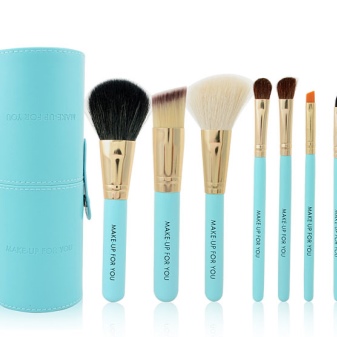
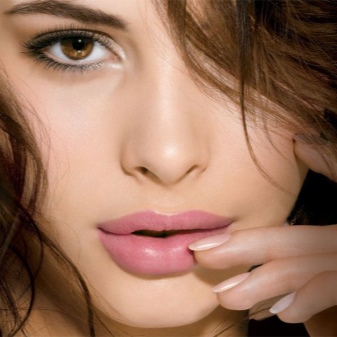
Another convenient and budget option is Divage.It applies the tone evenly and without gaps, due to its shape it is not quite suitable for shading, it can be difficult to vary the density, but this is absolutely not to be expected from a straight brush. It is soft and doesn't scratch. Serves long enough (at such a price), the hairs do not climb, and the engraving on the handle does not peel off. Suitable for both liquid creams and thick fat ones. The average rating is 4.5.
For a video tutorial on how to apply foundation with a brush, see the following video.




























